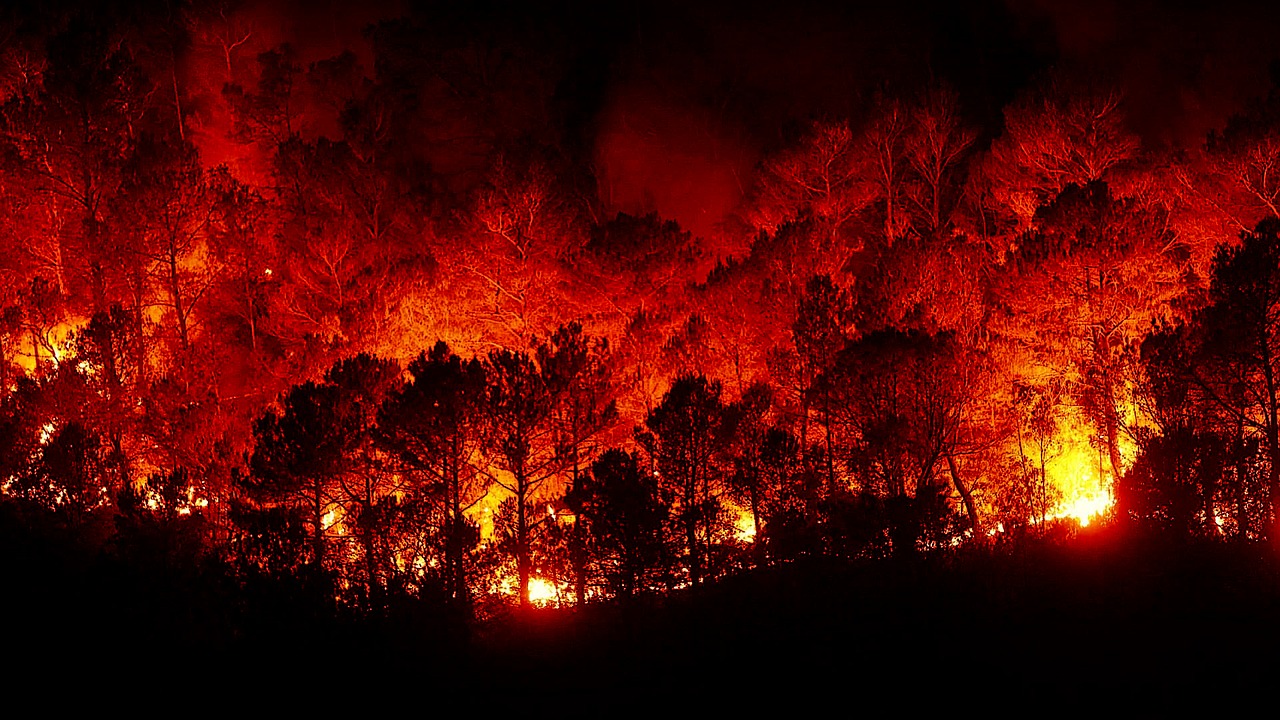Warming World = Worse Wildfires
Fires and floods are the most severe environmental threats to property and life. Usually I deal with floods, but this week a closer look at fire is warranted, particularly since there is a causal connection with climate change. All eyes are on California’s tragic wildfires at the moment. Less noticed was the tremendous surge in fires this summer all around the northern hemisphere. Terrible blazes ravaged Scandinavia, the Baltic, Alaska––pretty much across the high Arctic latitudes in the last few months.
That makes sense, since fires go along with warmer temperature, and the effects of global warming are more pronounced in the high Arctic. Though the trend has been changing for decades, it is now exploding. This graphic by NASA shows global temperatures last month, in an estimated comparison to reconstructed averages for the same month, from 50 – 100 years earlier. The red color shows that this October’s average temperatures were roughly 2 – 4 degrees Celsius (4-7 degrees Fahrenheit) above those a century ago.
After witnessing the aftermath of the California wildfires President Donald Trump said he had not changed his mind on climate change. Somewhat strangely, during a Saturday visit with firefighters to assess the damage, he told them, “I want great climate, we are going to have that and we are going to have forests that are very safe.” Also during an interview the day earlier, The Hill reports that Trump said climate change “maybe contributes a little bit” to the California fires, but maintained that: “the big problem we have is management.” In my view he is dead wrong on one count, but mostly correct on the other.
The facts are:
- The planet is warming, closely correlating with the rising level of the “greenhouse gas” carbon dioxide (CO2) now at 410 PPM (parts per million). The science has been affirmed by nearly all scientists, every major science organization, the leaders of all other G20 nations, and even the major oil companies. President Trump continues to dismiss the dangerous implications of the warming and stands virtually alone among world leaders in his position.
- Trees and brush are easier to ignite, when they are dry, or dead. For years fires have been on the increase, somewhat following the well-documented warming temperatures and extreme droughts. Climate change-related insect infestations like the pine bark beetle, which has killed millions of acres of lodgepole pine in the western United States and Canada, have also added to the vulnerable forest dead wood, the fuel for the wildfires.
- Larger numbers of people are living in forested areas adding to the exposure. Paradise California was a good example of people wanting an alternative to the high-priced housing in the Bay Area. Living in wooded areas is driven by the pull of a natural setting, those shunning expensive property values, and the ability to work remotely.
- Forests have not been well managed and the President is correct that there is big room for improvement, but we must do far more than rake the forest floor, as he described it. We need to do a better job at thinning the flammable underbrush using controlled burns and select timber removal.
- Finally, we need to improve our fire-fighting capacity. Because of the scope of major wildfires in the U.S., the resources need to be improved at a Federal level, augmenting the individual states capabilities. Congress has not provided adequate resources appropriate to the explosive growth in the number and scale of wildfires.
Even with improved forestry management and better fire fighting, we are still going to experience worse wildfires due to items #1 and 2. Thinning and prescribed burns can not solve the problem.
We also need to change building design and construction to adapt to the new reality and risk. The old ideas to reduce fire hazard are no longer adequate. I find that UCLA Professor of Architecture, Murray Milne’s article, “Designing Your Home to Survive Wildfires” makes a lot of sense. Fresh analysis and remedies should be incorporated into building codes, particularly in vulnerable areas.
Finally, we need to deal with the underlying point that the President desperately wants to ignore, in favor of promoting the increased use of fossil fuels: A warmer planet will have greater fire risk. The risk of fire does not rise in a linear relationship with warming climate. It rises exponentially. Those that continue to deny, thwart, and play games with short-term priorities such as promoting coal will leave a legacy, appropriately recalling Dante’s Inferno and other visions of “Hell.”
Unfortunately even an aggressive effort to reduce CO2 emissions will not quickly reverse the warming and the increased fire hazard due to the heat already stored in the sea. That is the same force that is changing ocean and atmospheric currents and melting the polar ice caps and glaciers. It is all connected. Thus we must do two things as the highest national – and international – priority:
- Take urgent steps to slow the warming, preferably using market-based incentives such as increasing costs associated with fossil fuels.
- Urgently change our homes, businesses, and communities to prepare for a world with far greater fires – and flooding. This requires a full re-evaluation of how we build and where.
This is not some game, political contest, or system of belief. We ignore this at our peril, and the peril of future generations.


